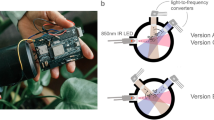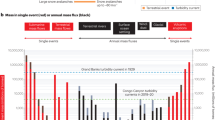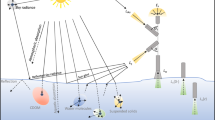Abstract
Open-source designs for turbidity and depth sensors are becoming increasingly capable and available, but the knowledge required to construct them limits their use compared with expensive, commercial sensors. Here we present an open-source optical backscatter and water pressure sensor that can be ordered almost fully assembled, requires no coding to deploy and costs approximately 50 USD. We share three examples of these sensors’ ability to facilitate new research. First, we observed complex changes in spatial and temporal patterns of suspended sediment transport in the Arctic Sagavanirktok River using a network of sensors. Second, we measured turbidity during the freeze-up period in the Tanana River, a period of high risk to sensors. Last, we built and deployed sensors with middle-school students to monitor turbidity under full ice cover on the Tanana River. The success of open-source sensors in these examples shows a marked increase in scale and accessibility of river science.
This is a preview of subscription content, access via your institution
Access options
Subscribe to this journal
Receive 12 digital issues and online access to articles
$99.00 per year
only $8.25 per issue
Buy this article
- Purchase on Springer Link
- Instant access to full article PDF
Prices may be subject to local taxes which are calculated during checkout





Similar content being viewed by others
Code availability
Documentation for building, calibrating, using and interpreting the OpenOBS-328 is available on our documentation site: https://tedlanghorst.github.io/OpenOBS-328/. Up-to-date files and code for the sensor design are available at the full repository path: https://github.com/tedlanghorst/OpenOBS-328 and archived at https://zenodo.org/record/8136530. The project is distributed with the GNU General Public License v3: https://www.gnu.org/licenses/gpl-3.0.en.html. Some of the libraries in the sensor firmware are modified from existing open-source projects and have retained other licences; these are documented in the directory of each library.
Data availability
Data and code for creating the figures shown in this manuscript are archived at https://zenodo.org/record/8136526.
References
Minella, J. P. G., Merten, G. H., Reichert, J. M. & Clarke, R. T. Estimating suspended sediment concentrations from turbidity measurements and the calibration problem. Hydrol. Process. 22, 1819–1830 (2008).
Leopold, L. B. & Maddock, T. The Hydraulic Geometry of Stream Channels and Some Physiographic Implications Vol. 252 (US Government Printing Office, 1953).
Gray, J. R. & Simões, F. J. Estimating sediment discharge. in Sedimentation Engineering: Processes, Measurements, Modeling, and Practice, Series no. 110, 1067–1088 (American Society of Civil Engineers, 2008).
Morehead, M. D., Syvitski, J. P., Hutton, E. W. H. & Peckham, S. D. Modeling the temporal variability in the flux of sediment from ungauged river basins. Global Planet. Change 39, 95–110 (2003).
Chikita, K. A., Wada, T., Kudo, I. & Kim, Y. The intra-annual variability of discharge, sediment load and chemical flux from the monitoring: the Yukon River, Alaska. JWARP 04, 173–179 (2012).
Mao, L. & Carrillo, R. Temporal dynamics of suspended sediment transport in a glacierized Andean basin. Geomorphology 287, 116–125 (2017).
Collins, A. L. & Walling, D. E. Documenting catchment suspended sediment sources: problems, approaches and prospects. Prog. Phys. Geogr. 28, 159–196 (2004).
Chen, C. Y. et al. Systemic racial disparities in funding rates at the National Science Foundation. eLife 11, e83071 (2022).
Corbett, L. B., Bierman, P. R., Semken, S. & Whittaker, J. A. Can community laboratory facilities increase access and inclusivity in geoscience? Earth Space Sci. 9, e2021EA002028 (2022).
Oellermann, M. et al. Open hardware in science: the benefits of open electronics. Integr. Comp. Biol. 62, 1061–1075 (2022).
Chan, K. et al. Low-cost electronic sensors for environmental research: pitfalls and opportunities. Prog. Phys. Geogr. 45, 305–338 (2021).
Eidam, E. F., Langhorst, T., Goldstein, E. B. & McLean, M. OpenOBS: open-source, low-cost optical backscatter sensors for water quality and sediment-transport research. Limnol. Oceanogr. Methods 20, 46–59 (2021).
Cory, R. M., Crump, B. C., Dobkowski, J. A. & Kling, G. W. Surface exposure to sunlight stimulates CO2 release from permafrost soil carbon in the Arctic. Proc. Natl Acad. Sci. USA 110, 3429–3434 (2013).
Ferrari, M. C. O., Lysak, K. R. & Chivers, D. P. Turbidity as an ecological constraint on learned predator recognition and generalization in a prey fish. Anim. Behav. 79, 515–519 (2010).
Downing, J. Twenty-five years with OBS sensors: the good, the bad, and the ugly. Cont. Shelf Res. 26, 2299–2318 (2006).
Matos, T. et al. Development of a cost-effective optical sensor for continuous monitoring of turbidity and suspended particulate matter in marine environment. Sensors 19, 4439 (2019).
Trevathan, J., Read, W. & Schmidtke, S. Towards the development of an affordable and practical light attenuation turbidity sensor for remote near real-time aquatic monitoring. Sensors 20, 1993 (2020).
Jiang, H., Hu, Y., Yang, H., Wang, Y. & Ye, S. A highly sensitive deep-sea in-situ turbidity sensor with spectrum optimization modulation–demodulation method. IEEE Sens. J. 20, 6441–6449 (2020).
Murphy, K. et al. A low-cost autonomous optical sensor for water quality monitoring. Talanta 132, 520–527 (2015).
Kelley, C. D. et al. An affordable open-source turbidimeter. Sensors 14, 7142–7155 (2014).
Droujko, J., Kunz, F. Jr & Molnar, P. Ötz-T: 3D-printed open-source turbidity sensor with Arduino shield for suspended sediment monitoring. HardwareX 13, e00395 (2023).
Beddows, P. A. & Mallon, E. K. Cave Pearl Data Logger: a flexible arduino-based logging platform for long-term monitoring in harsh environments. Sensors 18, 530 (2018).
Lyman, T. P., Elsmore, K., Gaylord, B., Byrnes, J. E. K. & Miller, L. P. Open wave height logger: an open source pressure sensor data logger for wave measurement. Limnol. Oceanogr. Methods 18, 335–345 (2020).
Temple, N. A., Webb, B. M., Sparks, E. L. & Linhoss, A. C. Low-cost pressure gauges for measuring water waves. J. Coast. Res. 36, 661–667 (2020).
Thaler, A., Sturdivant, S. K., Neches, R. & Black, I. Openctd: construction and operation. MarXiv https://osf.io/preprints/marxiv/8evsq/ (2020).
Favaro, E. A. & Lamoureux, S. F. Downstream patterns of suspended sediment transport in a high Arctic river influenced by permafrost disturbance and recent climate change. Geomorphology 246, 359–369 (2015).
Tananaev, N. Hysteresis effects of suspended sediment transport in relation to geomorphic conditions and dominant sediment sources in medium and large rivers of Russian Arctic. Hydrol. Res. 46, 232–243 (2015).
Schmidt, R. Mucking in the marshes. Endeavors https://endeavors.unc.edu/mucking-in-the-marshes/ (2022).
Kitchener, B. G., Wainwright, J. & Parsons, A. J. A review of the principles of turbidity measurement. Prog. Phys. Geogr. 41, 620–642 (2017).
Davies-Colley, R., Hughes, A. O., Vincent, A. G. & Heubeck, S. Weak numerical comparability of ISO-7027-compliant nephelometers. Ramifications for turbidity measurement applications. Hydrol. Process. 35, e14399 (2021).
Snazelle, T. T. Field comparison of five in situ turbidity sensors. USGS https://doi.org/10.3133/ofr20201123 (2020).
Münzberg, M., Hass, R., Dinh Duc Khanh, N. & Reich, O. Limitations of turbidity process probes and formazine as their calibration standard. Anal. Bioanal. Chem. 409, 719–728 (2017).
Kirkey, W. D., Bonner, J. S. & Fuller, C. B. Low-cost submersible turbidity sensors using low-frequency source light modulation. IEEE Sens. J. 18, 9151–9162 (2018).
Kinar, N. J. & Brinkmann, M. Development of a sensor and measurement platform for water quality observations: design, sensor integration, 3D printing, and open-source hardware. Environ. Monit. Assess. 194, 207 (2022).
Droujko, J. & Molnar, P. Open-source, low-cost, in-situ turbidity sensor for river network monitoring. Sci. Rep. 12, 10341 (2022).
Sanchez, R., Groc, M., Vuillemin, R., Pujo-Pay, M. & Raimbault, V. Development of a frugal, in situ sensor implementing a ratiometric method for continuous monitoring of turbidity in natural waters. Sensors 23, 1897 (2023).
Acknowledgements
We thank the students at the Nenana City School and their teacher, B. Gerald, as well as the CyberLynx students and their coordinator, J. Stone, for their participation and help with building sensors. We also thank the Toolik Field Station staff, organized by A. Young, for their help retrieving our sensors from the Sagavanirktok River at the end of the 2022 summer season. This sensor development and work on the Tanana River was supported by NSF grant 2153778 (PI E.E.). The data collection on the Sagavanirktok River was supported by The Preston Jones and Mary Elizabeth Frances Dean Martin Trust Fund in the Department of Earth, Marine and Environmental Sciences at the University of North Carolina at Chapel Hill and NSF grant 1748653 (PI C.G.).
Author information
Authors and Affiliations
Contributions
T.L., E.E. and L.C. developed the OpenOBS-328 sensors and testing methodologies. T.L. and T.P. conceived the manuscript. T.L. wrote the manuscript and analysed the data. T.L., T.P., E.E., L.C., J.D., K.S., S.C., C.A., A.B., E.F. and C.G. participated in field work efforts and provided data for this manuscript. All authors reviewed the results and draft manuscript.
Corresponding author
Ethics declarations
Competing interests
The authors declare no competing interests.
Peer review
Peer review information
Nature Water thanks Vincent Raimbault, Jessica Droujko and the other, anonymous, reviewer(s) for their contribution to the peer review of this work.
Additional information
Publisher’s note Springer Nature remains neutral with regard to jurisdictional claims in published maps and institutional affiliations.
Integrated supplementary information
Extended Data Fig. 1 OpenOBS-328 Sensor Performance.
a) Distribution of calibration error based on 72 OpenOBS-328 sensors and 3 RBR sensors. The boxplot centers represent the median values, and edges of the boxes represent the 25th and 75th percentiles. The whiskers extend to 1.5 times the inter-quartile range of the data. Points beyond the whiskers are plotted as open circles. b) Estimated and tested battery life for non-rechargeable Lithium Thionyl Chloride (Li-SOCl2; 2000 mAh) and rechargeable Lithium-Ion (Li-ion; 800 mAh) AA-size batteries. The disconnected points at 1 s for each battery represent continuous mode and the lines greater than 5 s represent measurement intervals with low-power sleep between measurements. Estimates are extrapolated from the current draw measurements. Tested values represent programming a sensor and letting it fully run down a new battery in a laboratory environment.
Supplementary information
Supplementary Information
Supplementary Figs. 1–8.
Rights and permissions
Springer Nature or its licensor (e.g. a society or other partner) holds exclusive rights to this article under a publishing agreement with the author(s) or other rightsholder(s); author self-archiving of the accepted manuscript version of this article is solely governed by the terms of such publishing agreement and applicable law.
About this article
Cite this article
Langhorst, T., Pavelsky, T., Eidam, E. et al. Increased scale and accessibility of sediment transport research in rivers through practical, open-source turbidity and depth sensors. Nat Water 1, 760–768 (2023). https://doi.org/10.1038/s44221-023-00124-2
Received:
Accepted:
Published:
Issue Date:
DOI: https://doi.org/10.1038/s44221-023-00124-2
This article is cited by
-
Open-source self-made sensors show high potential in river research
Nature Water (2023)



